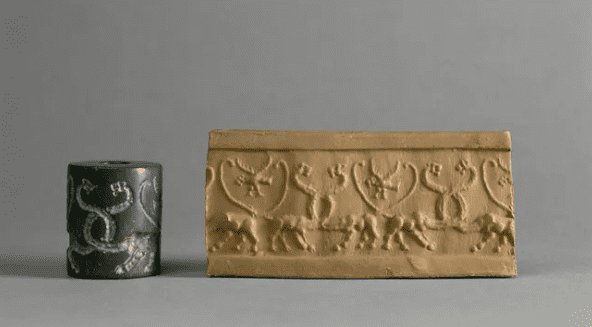The journey to written language didn’t begin with storytellers or philosophers—it started in the markets and temples of ancient Mesopotamia. A new study suggests that the first writing system, proto-cuneiform, evolved from symbols etched on seals used to keep track of trade goods like grains, textiles, and oils. Imagine these as the ancient world’s “receipts,” capturing each transaction, but with a lot more artistry and meaning packed into every symbol.
From Simple Seals to Proto-Writing
These seals were far from just plain stamps; they were intricate designs engraved on small cylindrical stones, rolled over clay to leave unique imprints. Merchants or temple officials would roll a seal over wet clay to record their transactions. Picture it: a bustling Mesopotamian marketplace where priests and traders alike relied on these symbols to ensure their goods were accounted for.
In the recent study, researchers examined seals dating as far back as 4400 B.C.—a full millennium before formal writing appeared. These symbols weren’t yet a “language” in the way we think of it, but they were a crucial step towards one. According to researchers Kathryn Kelley and Mattia Cartolano from the University of Bologna, these symbols evolved into the building blocks of cuneiform, the world’s first recognized script. As trade grew and records became essential, these symbols were modified, combined, and streamlined into proto-cuneiform—a way to track everything from jars of grain to bolts of cloth.
The Role of Temples and Trade
It’s hard to overstate how critical trade and temples were in early Mesopotamia. Temples served as economic hubs, controlling vast stores of grain, textiles, and even livestock, making them both the banks and superstores of their time. It’s easy to see how the need to track the flow of goods into and out of temples pushed the development of a more formal record-keeping system.
One common motif on seals showed jars, likely a shorthand for valuable resources, while another depicted cloth or fringe patterns representing textiles—a major trade item. The researchers believe these motifs morphed into symbols in proto-cuneiform, setting the stage for more complex ideas to be conveyed.

More Than Just Transactions
The shift from preliterate symbols to proto-cuneiform also reflects a leap in human cognition. Dr. Silvia Ferrara, a co-author of the study, calls this jump the “cognitive bridge” that marked humanity’s transition from prehistory to history. Imagine the leap from basic symbols representing objects to stylized symbols representing concepts—something that required imagination, abstraction, and a touch of genius.
This “prewriting” method marked the first known instances where humans began to visualize intangible ideas and experiences, rather than just items in a marketplace. It’s the first hint of human creativity meeting practicality, all to manage a thriving economy.
Decoding Ancient Symbols Today
For researchers today, these seals are like the ultimate cryptic crossword puzzle. Many symbols are general, like a long rectangle that could mean “jar” or simply “storage.” But the study’s findings suggest these symbols weren’t arbitrary; they had continuity and purpose, developing from imagery into writing.
There’s still skepticism from scholars like anthropologist Gordon Whittaker, who cautions against seeing direct links between these motifs and full-blown writing. Some symbols might just be common shapes with no clear bridge to language. Yet for Holly Pittman, an archaeologist who proposed a similar theory decades ago, the study vindicates her early ideas about the connection between seals and proto-cuneiform.
The Legacy of the First Written Words
Proto-cuneiform laid the groundwork for the famous wedge-shaped cuneiform script, where a stylus created impressions in clay to represent spoken sounds and words. First mastered by the Sumerians and later adopted by the Akkadians, cuneiform became the backbone of Mesopotamian communication for thousands of years. It not only recorded business transactions but also immortalized laws, poetry, and even love letters.
From these humble origins—simple marks on seals rolled across clay—the written word was born, changing history forever. Imagine if our modern contracts, emails, or text messages someday form the basis of a new language! This discovery shows that our need to communicate, orgdanize, and leave our mark on the world goes back far longer than we ever imagined.
So, the next time you scroll through a long receipt or check your messages, remember: the very first writing system was sparked by the humble act of trading goods, one clay seal at a time.












Leave a Reply